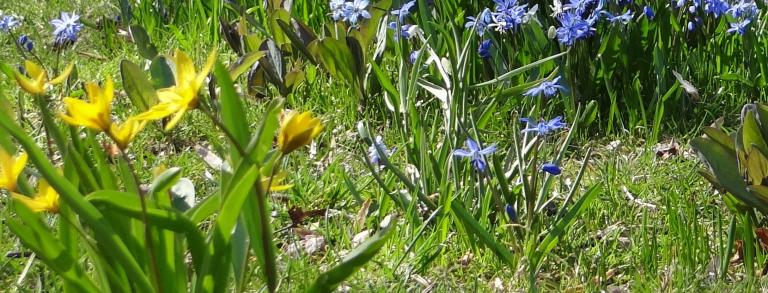MY NAME IS Anna, and I am a plantoholic. I lust after new plants of all kinds. I want more of the favorite plants I already have, and I am also in Zone denial, trying to grow all kinds of specimens from warmer climes. Surely this winter will be warmer, right?
We have lived in our house for 46 years. There are perhaps five trees, two shrubs, a perennial, and some bulbs left from the original design. Much has been added. Plants have grown, and space and light are tight. We cannot now remove shrubs and trees I planted for the short term due to local by-laws, so what can I do?
The lawn! Fourty years ago it took Sandy two hours to mow the lawn. Today there are many more flowerbeds, and mowing the remaining lawn only takes a half hour, which includes moving benches. I won’t dig up more lawn as you need somewhere to view the plants, and an even smaller lawn would look out of place.
We have a large liriodendron which was planted in 1987. Lower branches have been removed so there is enough light for grass to grow fairly well between the tree’s roots. This is a suitable place to plant bulbs, as many species die down rapidly and are ideal for deciduous shade.
In 2011, I dug pockets in the lawn and inserted bulbs of Fritillaria meleagris, Tulipa sylvestris, T. turkestanica, T. humilis ‘Lilliput’, Muscari armeniacum and Narcissus pseudonarcissus. Leaves emerged the next spring with good flowering from the tulips and muscari plus a few lovely bells of white and regular checkered fritillaria. I was not surprised to see Scilla siberica spontaneously joining the group. However, many of the bulbs did not perform.
We let the flowers die down, and the grass (plus dandelions and other weeds) grow up. I scattered seeds from the few seed pods. The area is mown in early July when it reverts to a normal weedy lawn.
A Dodecatheon meadia ‘Alba’ appeared the next year unexpectedly even though I hadn’t grown one for ten years. It was joined by more scilla, Mertensia virginica, Chionodoxa luciliae, Crocus tommasinianus, Galanthus nivalis, and Puschkinia scilloides. These have all seeded in from nearby beds. The fritillaria increased and some of the narcissus flowered.
Now Corydalis solida is coming up in the main lawn. I have a colony of varying shades under a yellowwood plus some ‘Beth Evans’ nearby. As they seed, I keep only the best colors.
Primula veris grows close by in a semi-shaded bed, and now small plants are arriving in the bulb lawn area. They do not appreciate the July mowing and have not yet flowered.
I loved big patches of Tulipa ‘Angelique’ in my grandmother’s lawn 75 years ago so I planted five bulbs. Only one flowered in my lawn, and I think they have died through lack of light. Small strawberries suddenly appeared last year. I delightedly ate one, but it was seedy and tasteless. However, the small, red dots add to the green lawn. The flowers hardly show. It must be Duchesnea indica, the mock strawberry (or Indian strawberry). I had never seen it before!
This year I am planting seeds from the NARGS seed exchange in the lawn as soon as the snow melts. The habitat should work for cyclamen, camassia, and Lilium martagon. The latter self-seeded under my uncle’s beech tree. Will this work here?
There are a few problems, mainly lily beetle. These are easy to find and remove by hand. Perhaps Mertensia virginica is too rampant, but it is easy to pull up. The grass is also too vigorous. I will try planting seeds of the hemiparasite Rhinanthus minor (yellow rattle). This is used extensively in Britain to reduce the growth of grasses in wildflower meadows.
It is exciting to see what appears and how my plantings have grown. Why not establish a bulb lawn in a corner of your garden?


